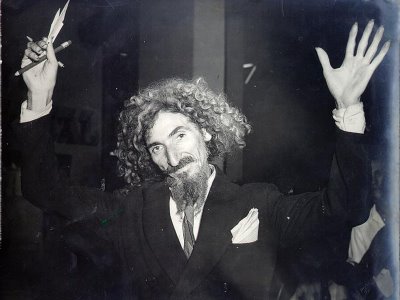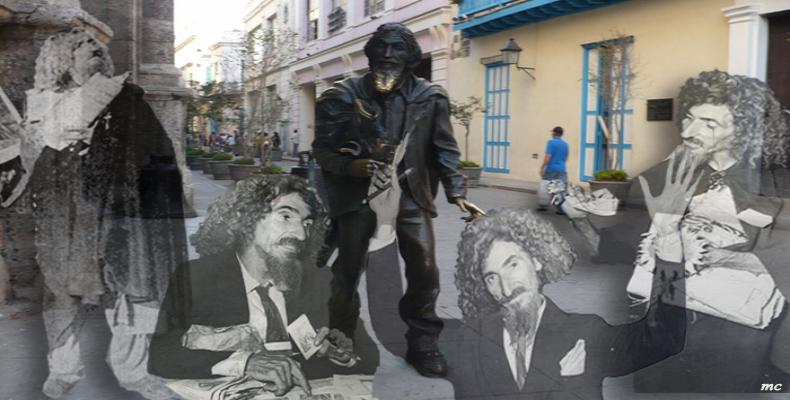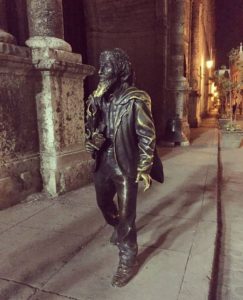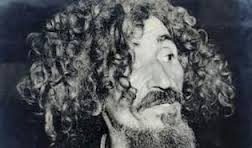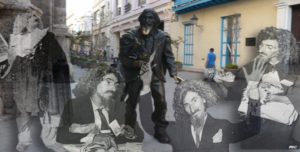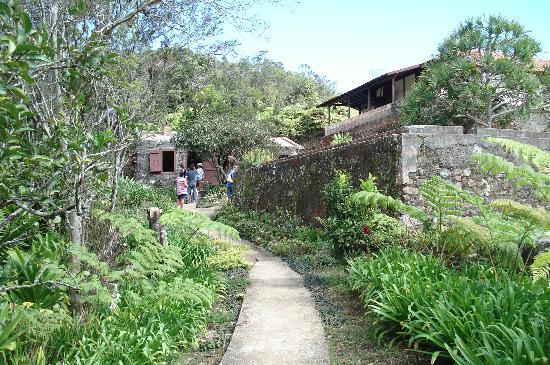One of the oldest streets and therefore also more touristy of the city of Havana, is the Street of the Trades. It is in the historical center of the Cuban capital and walking through it you suddenly find a bronze statue of life size, located at the entrance of the Basilica Minor of the Convent of St. Francis of Assisi.
National and foreign visitors, stop in front of the bronze figure, take photos, caress his beard, and shiny before the rubbing of so many hands, or simply leave a flower.
Who? Some people ask. Almost immediately, this question is answered: “It is the Knight of Paris.”
The Bronze Noble calls the attention of many who tell their story becomes necessary.
His real name: José María López Lledín. He was born on December 30, 1899 in the province of Lugo, Spain. According to the documentation of the National Archive, he arrived in Havana on December 10, 1913 at the age of 12. Legend has it that for some crime he ended up in the galleys of Castillo El Príncipe, imprisoned until the end of the 1920s, when he began to walk the streets of the city without a home or a roof.
Of medium height, long gray hair, pensive, without much agreement or sanity, he dressed in black, with a cloak, like a musketeer. He was a gentle, talkative, educated and spontaneous man, all who shared with him remember their talks about life, religion, politics and the events of the day. He never asked for money. He stood out for carrying a folder of papers and a handful of pencils
Which gave him a certain intellectual air.
Thus it became a popular personage that was usual to see by several corners of the city, mainly by the Paseo del Prado, the Avenue of the Port, the Plaza de Armas, 23 and 12, and the Central Park.
As for his nickname, The Knight of Paris, there are thousands of versions about its origin. Some say it comes from a French novel; Others, who popularly obtained the description of the sidewalk of the Paseo del Prado that in his mind was equivalent to the sidewalk of the Louvre; While many claim that he used to call himself “King” and “Knight.” The truth is that he became a living legend of the streets of Havana and those who knew him always have something to tell about him.
He witnessed the convulsive life of Havana and the country until in 1977 he was admitted to the Psychiatric Hospital of the capital.
He died a July 11, 1985 at the age of 86, initially, was buried in the cemetery of Santiago de las Vegas in Havana. Years later, his remains were exhumed by the historian of the City of Havana, Eusebio Leal, and transferred to the interior of the chapel of the convent of San Francisco de Asís, very near the statue.
Imperishable legends were created around this “Knight”; And many of them have inspired writers, filmmakers and artists. Certainly, as every legend never dies, and the creative magic of the sculptor José Villa Soberón perpetuated its bronze figure to continue wandering the streets of Havana.
Agencies / Rad.Habana / Internet Photos / YouTube / Arnoldo Varona / TheCubanHistory.com
THE CUBAN HISTORY, HOLLYWOOD.
FOLLOW US ON TWITTER AND FACEBOOK. THECUBANHISTORY.COM

“EL CABALLERO DE PARÍS” EN CUBA Y SU SIEMPRE PRESENTE FIGURA.
Una de las calles más antiguas y por lo tanto también más turísticas de la ciudad de La Habana, es la Calle de los Oficios. Está en el casco histórico de la capital cubana y caminando por ella te topas de repente con una estatua de bronce de tamaño natural, situada a la entrada de la Basílica Menor del Convento de San Francisco de Asís.
Visitantes nacionales y extranjeros, se detienen frente a la figura de bronce, para tomarse fotos, acariciar su barba, ya brillosa ante el roce de tantas manos, o simplemente dejarle una flor.
¿Quién es? preguntan algunos. Casi de inmediato, tal interrogante encuentra respuesta: “Es el Caballero de París”.
A tantos llama la atención el noble de bronce que contar su historia se vuelve necesario.
Su verdadero nombre: José María López Lledín. Nació un 30 de diciembre de 1899 en la provincia de Lugo, en España. De acuerdo con la documentación del Archivo Nacional, llegó a la Habana el 10 de diciembre de 1913 con 12 años de edad. Dice la leyenda que por algún delito terminó en las galeras del Castillo el Príncipe, encarcelado hasta fines de los años 20, cuando empezó empezó a recorrer las calles de la ciudad sin hogar ni techo.
De mediana estatura, pelo largo y canoso, meditabundo, sin mucho arreglo ni cordura, vestía de negro, con capa, cual mosquetero. Era un hombre gentil, conversador, educado y espontáneo, todos los que compartieron con él recuerdan sus charlas sobre la vida, la religión, la política y los eventos del día. Nunca pidió dinero. Resaltaba por llevar una carpeta de papeles y un puñado de lápices
que le dotaban de cierto aire intelectual .
Así se convirtió en un popular personaje que era usual ver por varios rincones de la ciudad, principalmente por el Paseo del Prado, la Avenida del Puerto, la Plaza de Armas, 23 y 12, y el Parque Central.
En cuanto a su apodo, El Caballero de París, existen miles de versiones sobre su origen. Algunos dicen que proviene de una novela francesa; otros, que obtuvo popularmente el calificativo de la acera del Paseo del Prado que en su mente equivalía a la acera del Louvre; en tanto muchos afirman que el solía nombrarse a si mismo “Rey” y “Caballero”. La verdad es que se convirtió en una leyenda viva de las calles de La Habana y quienes le conocieron siempre tienen algo que contar sobre él.
Fue testigo de la convulsionada vida de La Habana y el país hasta que en 1977 se le internó en el Hospital Psiquiátrico de la capital.
Murió un 11 de Julio de 1985 con 86 años de edad, inicialmente, fue enterrado en el cementerio de Santiago de las Vegas en La Habana. Años más tarde, sus restos fueron exhumados por el historiador de la Ciudad de La Habana, Eusebio Leal, y transferidos al interior de la capilla del convento de San Francisco de Asís, muy cerca de la estatua.
Leyendas imperecederas fueron creadas en torno a este “Caballero”; y muchas de ellas han servido de inspiración a escritores, cineastas y artistas. Ciertamente, como toda leyenda nunca muere, y la magia creadora del escultor José Villa Soberón perpetuó su figura en bronce para que continúe deambulando por las calles de la Habana.
Agencies/Rad.Habana/Internet Photos/YouTube/Arnoldo Varona/TheCubanHistory.com
THE CUBAN HISTORY, HOLLYWOOD.



